Scotland's Pictish stones like you have never seen before


Historic Environment Scotland (HES) has released images of how the stones may have looked if pigment had been used to decorate the stonework.
Illustrations depicting coloured versions of some of Scotland’s most significant Pictish stones are now on show at a number of sites including Aberlemno in Angus, Maiden Stone at Inverurie, Dunfallandy near Pitlochry and Knocknagael near Inverness.
Advertisement
Hide AdAdvertisement
Hide Ad

The pictures show half of the sculpture in colour and the other half in its natural stone state.
HES said the aim had been to give visitors “an impression of the effect of colour on these remarkable sculptures.”
“These stones were clearly the products of a highly-capable visual culture and were designed to be widely seen. Adding colour would have greatly enhanced that visual impact of the relief and incised decorations,” a spokesman for HES said.


Picts controlled parts of Scotland north of the Forth from 290AD to 900 AD with the tribe routinely fighting the advance of the Romans, who abandoned Britain in 410AD.
Advertisement
Hide AdAdvertisement
Hide AdWhile there was “no direct evidence” that Pictish stones in Scotland were coloured, some pigment had survived on contemporary stonework from Northumbria and Mercia.
There is also evidence of the use of colour on sculpture by the Romans, who had a significant cultural influence on the Picts.
Artistic use of colour on Pictish metalwork was also referenced contemporary Christian manuscripts like the Book of Durrow and the Book Kells.


The spokesman said: “The hypothesis is supported by many Pictish scholars as probable or the very at least possible.
Advertisement
Hide AdAdvertisement
Hide Ad“We drew on their advice throughout this project. Nevertheless, our images are speculative.”
It is believed the Picts may have used colour to bring out the designs and make their meaning clearer and easier to understand.
They may have made their paint using a white base or primer of gesso that probably incorporated chalk.


This would have been used to cover those parts of the stones that were to be coloured.
Advertisement
Hide AdAdvertisement
Hide AdThe pigments may then have been applied on top by artists, perhaps drawing inspiration and guidance from illuminated manuscripts that have since been lost, according to HES.
The spokesman said: “We can imagine that mineral-based colours were part of the Pictish palette, such as green verdigris, red lead, yellow ochre.
“Perhaps organic pigments like woad (a common plant) could have added other hues like blue, although they might have required regular reapplication as they may have faded rapidly exposed to the sun and elements.
“We simply do not know. However, some scholars argue that the palette would have consisted of bright, primary colours and the effect may have been garish to modern eyes.
Advertisement
Hide AdAdvertisement
Hide AdThe impact of the sun, rain and wind would likely have scrubbed pigment away from the Scottish stones.
“However, it may been possible to use modern scientific techniques to look for traces of pigment surviving in nooks and crannies,” the spokesman added.
